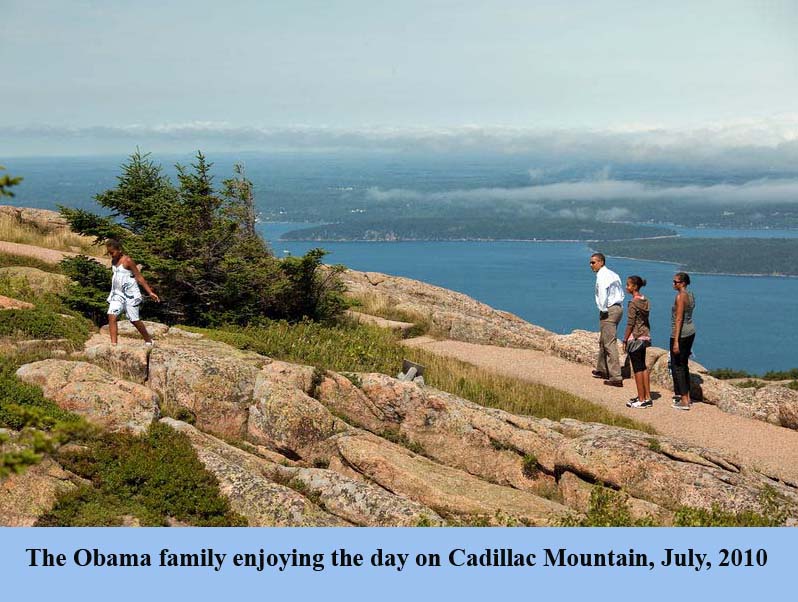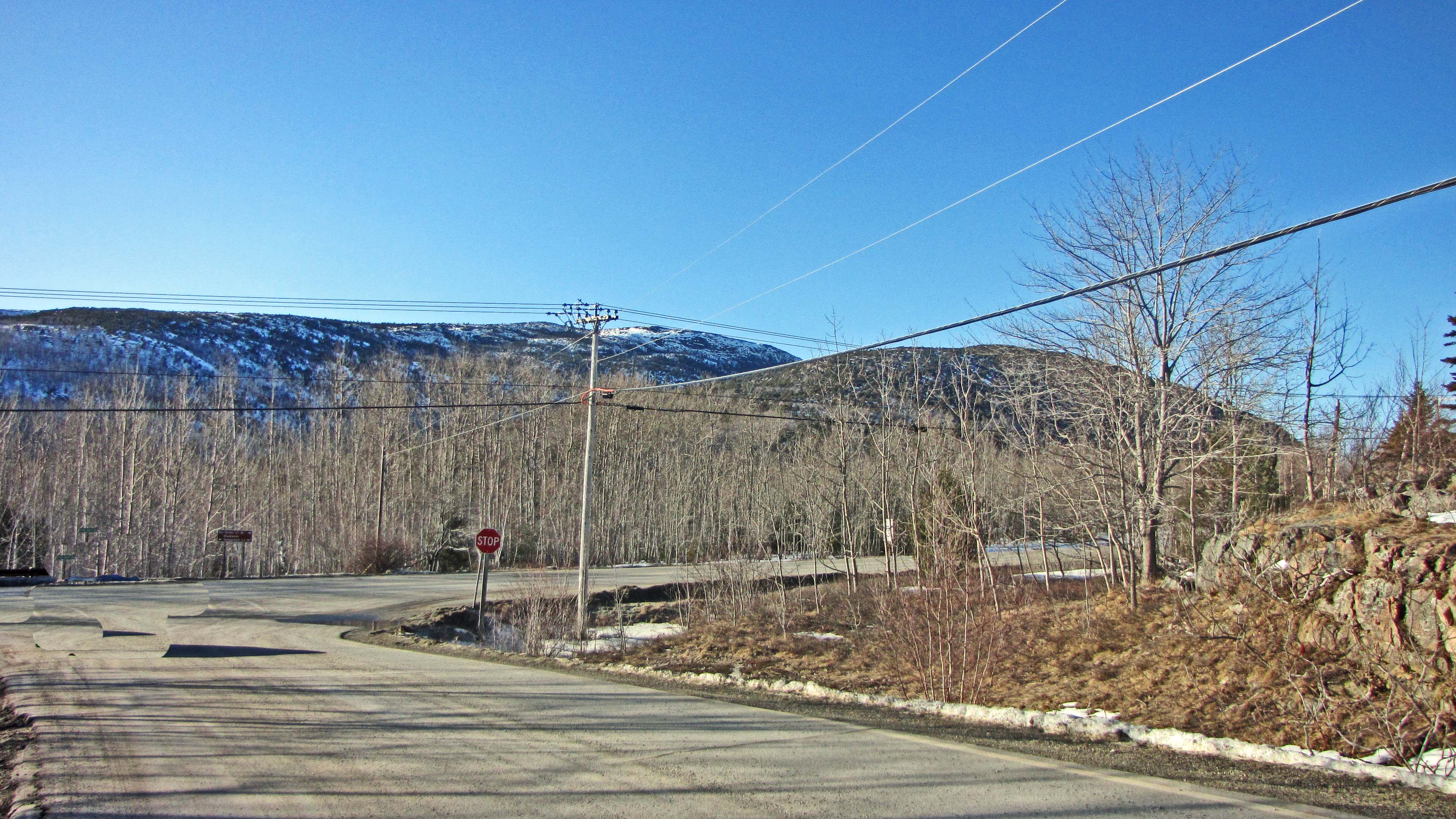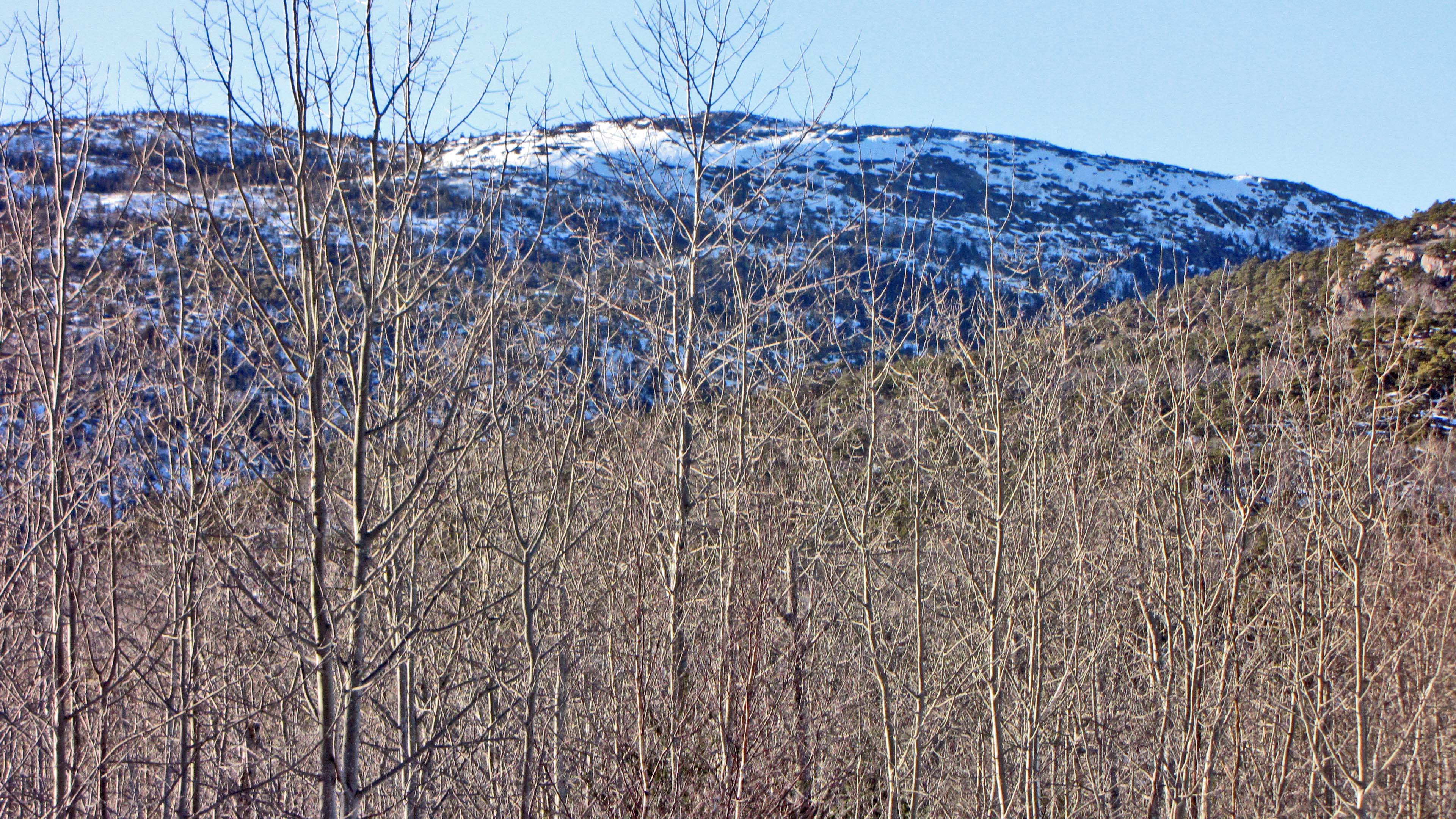

The great mountain pictured above is the highest Atlantic Coast peak north of the equator. Its name honors the first European to own this land, the Frenchman who founded Detroit. Located in northeastern Maine not far from the border with New Brunswick, Cadillac Mountain is the first point in the continental United States to be graced by the rays of the sun every morning from October to March. It is 1,530 feet in height and is within what is, perhaps, the most magnificent national park east of the Mississippi—Acadia.
The first Europeans to visit this area were probably sailors and fishermen from the Nordic countries who stayed here for the su mmer while they fished. But they left few records of their voyages. and did not attempt to settle. The Portuguese explorer, Estévan Gomes, cruised along the coast of Maine in 1525 seeking a passage to the Orient. He thought that the Penobscot River was that passage and sailed that river as far as present-day Bangor before realizing his mistake. Presumably, he sailed around Mount Desert Island where Mount Cadillac is located.
mmer while they fished. But they left few records of their voyages. and did not attempt to settle. The Portuguese explorer, Estévan Gomes, cruised along the coast of Maine in 1525 seeking a passage to the Orient. He thought that the Penobscot River was that passage and sailed that river as far as present-day Bangor before realizing his mistake. Presumably, he sailed around Mount Desert Island where Mount Cadillac is located.
The French explorer, Samuel de Champlain, was among the first Europeans to explore this area and then offer written comments and detailed maps. North American Indians wished to trade with the Europeans so that wanted to keep them around. Indians, of course, could not obtain European goods unless European more or less settled in their area and regularly got supplies from their Motherlands. Apparently, many Indians realized that the Europeans would stay and trade if they believed there was a city of gold at some mysterious location not very far away. The Indians in Maine told Europeans about Norumbega—a walled and very wealthy city at some undefined location in the wilds of present day Maine or Québec. Many naive European explorers believed the Indians and presumed they could locate the city of gold. King Henry IV of France encouraged Champlain to sail along the Maine coast and up the rivers to discover that rich city. On September 5, 1604, Champlain gave this area the name it bears today—Mount Desert Island. In his words, “Le sommet de la plus part d’icelles est desgarny d’arbres parceque ce ne sont que roches. Je l’ay nommee l’Isle des Monts-déserts.” That is, there were only rocks on the mountain so Champlain gave the location its present name Isle des Mont déserts. The term desert in late Medieval French and English described a location with little flora and thus, until about 1845, the Great Plains of this country were called the American desert. Today we associate desert with a large sandy area with few trees or bushes.
Needless to say, the French did not find a city of gold in northern Maine. I do not know how long it took for the Europeans to realize that there were no great cities of gold in America and that there was no easy water route to Asia. In 1613, Pierre Biard, a French Jesuit who was a professor of theology at the university in Lyon before his American travels, intended to establish a mission at the mythical city of Norumbega which he presumed was located near present-day Bangor, Maine on the Penobscot River. When he arrived at I’lsle des Mont Déserts, he and his colleagues were welcomed by the Indians so they remained there and sought to establish a mission. Later that summer, an Englishman from the Jamestown colony sailed to this island, claimed it for the British Crown and forcefully removed the French. So much for the first European settlement here.
Antoine Laumet, the son of a Gascony lawyer, wished to seek his fortune in the New World. He decided to change his name to the more aristocratic sounding La Mothe and then added a title “Sieur de Cadillac” using the name of a small Gascon town. Antoine Cadillac sailed to Québec and, in 1688, obtained a grant from the Governor of Canada for a large area that is now along the northeast coast of Maine. His land grant extended six miles inland and six miles to the east and west of the present Sullivan River. His grant  also included I’Ilse des Monts Déserts. Presumably, Cadillac intended to establish an estate at this location and, perhaps, a prosperous trading post. At this time, the Wabanaki Indians spent their summers on the island. Cadillac and his wife apparently spent part of one summer on his property and then decided to give up on this endeavor. They returned to Montréal but Cadillac provided an accurate description of the island. His account is now in the French archives but has been reproduced in several publications about the history of Maine. If there is any doubt, it provides that Cadillac was literate and was able to provide a fairly comprehensive description of the place he intended to settle. Having not found a fortune in Maine, Cadillac became a fur trader, first at the Straits of Mackinac and then later received approval from the French Crown to establish Detroit which he did in July, 1701.
also included I’Ilse des Monts Déserts. Presumably, Cadillac intended to establish an estate at this location and, perhaps, a prosperous trading post. At this time, the Wabanaki Indians spent their summers on the island. Cadillac and his wife apparently spent part of one summer on his property and then decided to give up on this endeavor. They returned to Montréal but Cadillac provided an accurate description of the island. His account is now in the French archives but has been reproduced in several publications about the history of Maine. If there is any doubt, it provides that Cadillac was literate and was able to provide a fairly comprehensive description of the place he intended to settle. Having not found a fortune in Maine, Cadillac became a fur trader, first at the Straits of Mackinac and then later received approval from the French Crown to establish Detroit which he did in July, 1701.
There was no rush to settle Mount Desert Island, but after the British expelled the French from North America in 1760, the British government granted the island to Sir John Bernard. During the Revolution, Bernard opted to support the independence movement so he thought that he had a valid claim to the entire island after the British were defeated by the American Revolutionaries. However, in 1786, Madame Barthelmy de Grégoire, a granddaughter of Antoine Cadillac, went to Boston with documents that, she presumed, gave her control of the island. At this time, Maine was part of Massachusetts so the courts in the state capital handled land claims pertaining to Mount Desert Island. Indeed, Maine did not gain its independence from the Bay State until 1820. The Massachusetts courts evaluated the rival claims for Mount Dessert Island. They decided that the eastern half of the island and a portion of the mainland belonged to Madame Barthelmy de Grégoire while the western half of the island belonged to John Bernard. Madam de Grégoire lived on the island until her death in 1811. So far as I know, there are currently no descendents of Antoine Cadillac living in this area of Maine.
By the 1850s, Mount Desert Island became a resort for prosperous Boston families who would sail or take a steam powered vessel to this area for their summer retreat. The village of Bar Harbor was established and, before the Civil War, the last remaining Indian residents were strongly encouraged to leave. These prosperous summer residents eventually came to understand the beauty of the island where they lived. Many built very large and expensive “cottages” here, solidly constructed homes that still stand along the waterfront in the village of Bar Harbor. Members of the Astor, Morgan, Pulitzer, Rockefeller and Vanderbilt families had summer homes here. Later in the Nineteenth Century, George Bucknam Darr, who earned a fortune in the textile industry, began assembling property that would eventually become a park. Supposedly, the great American landscape architect, Charles Elliott, developed the idea for a part on the island. Elliott, after studying at Harvard, apprenticed with John Law Olmstead, helped created the marvelous Boston Metropolitan Park system and spent time in 1884 in Detroit working on the design of Belle Isle. The early decades of the last century were an era when there was much enthusiasm for creating national parks that might preserve the country’s beauty for future generations. Most of the national parks were established in the West. However, the summer visitors to Mount Desert Island—who by this time owned large tract of lands—realized the beauty of their area. They succeeded in having President Wilson designate a large part of the island as the Sieur de Monts National Monument on July 8, 1916 to be administered by the National Park Service. Just three years later, President Wilson—on February 26, 1919—established the first national park east of the Mississippi. It was named for Marquis de Lafayette, the Frenchmen who played a key role in the success of the American Revolution.
A resident of the area—who did not appreciate the use of French names—was willing to contribute a large tract of land on the Schoodic Peninsula to the national park on the condition that the park not be named after any Frenchman. Perhaps influenced by the opportunity to greatly expand the size of Lafayette National Park, federal officials, in 1929, accepted the gift and then changed the name to Arcadia National Park. There must have been considerable local debate about whether it was desirable to name parks and sites after French individuals. This part of Maine in not very close to the large stretch of northern Maine continuous to Québec and New Brunswick where French is frequently spoken.
The Mountain you see pictured above had been known for years as Green Mountain. In 1934, the name was changed to Cadillac Mountain. Bar Harbor is the small city located here but the term Bar Harbor is often used for the larger Mount Desert area that encompasses Acadia Park which includes Cadillac Mountain. John David Rockefeller, Jr. maintained a summer cottage in this area. He contracted with landscape architect, Beatrix Farrand, to build, between 1915 and 1933, 80 kilometers of gravel carriage roads within the park, as well as 17 extremely attractive granite bridges for the carriage trails and two stone gate lodges. These are still in use and well maintained. Farrand, among the leading landscape architect of her age, designed the grounds for the National Cathedral in Washington, landscaped the White House during the Wilson Administration and designed the grounds of the Dumbarton Oaks estate in Georgetown where international deliberations in 1944 laid the foundation for the United Nations. In her later life, Farrand lived on Mount Desert Island.
There is controversy about the origin of the frequently use term. One speculation is that French explorers sought to pronounce the Avenaki or Micmac word “quoddy” meaning place. The best they could do was “cadie.” Another speculation is that Giovanni da Verrazano explored the Maine coast in the 1520s and thought the scenery reminded him of the Arcadia section of the Greek coast. So the origin of the word is, presumably, Greek, Avenaki or Micmac but certainly not French.
There is another interesting Detroit and Michigan connection to Mount Desert Island. Clarence Cook Little studied genetics at Harvard, became a professor and moved through the academic ranks. In 1922, he was appointed president of the University of Maine. Three years later, the Board of Regents selected him to serve as president of the University of Michigan. He proved to be an extremely controversial choice, perhaps because he constantly pushed the Regents to support genetic research, but also because he spoke out in favor of eugenics, birth control and euthanasia. Between the world wars, the eugenics movement became quite popular in this country with advocates such as President Clarance Cook Little. Realizing that the Regents did not appreciate his work, he resigned as president of the University of Michigan in 1929 to establish a genetics research laboratory at Bar Harbor using land donated by George Darr. This non-profit organization continues today as a large research center conducting genetic studies to understand and cure diseases. Little raised money from Detroit entrepreneurs who had summer homes at Bar Harbor to fund his research. Indeed, Edsel Ford was one of three major contributors. The center was named after Roscoe Jackson, the president of Detroit’s Hudson Motor Car Company who had recently been killed in an automobile accident. Little was one of the founders of the American Cancer Society. From 1954 to 1969, C. C. Little served as the lead scientist for a research organization supported by the nation’s tobacco firms. He was among the last scholars to stoutly defend the hypothesis that cancer was the result of genetics not of tobacco consumption. Later in his life, he agreed that tobacco consumption might play some role in cancer, but in his view, the major cause of cancer was genetic.
The Bar Harbor area continues to be a summer vacation destination for quite a few prosperous and famous individuals. Four presidents of the United States have taken summer vacations at this location. President Obama and his family vacationed here in July, 2010; the first president to do so since President Taft a century earlier.
Photograph: Ren Farley; February 19, 2010
Description updated: July, 2010
Return to Sports, Parks and Recreation
Return to Home Page